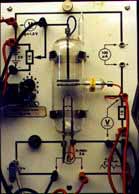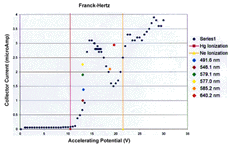
Electrons are accelerated through a thin gas of neon and mercury from a hot filament towards a collection electrode. As the accelerating voltage is increased, electron velocities (and energies) become larger, increasing the current between a hot-filament cathode and collector anode. However, for sufficient electron energies, inelastic collisions can occur with the neon and mercury atoms. The object is to adjust the accelerating potential so that the electrons may cause collisional excitation of the gas atoms. This is observed by the subsequent de-excitation, and spectral line emission of the atoms. As a result of these collisions, many electrons are unable overcome a small retarding potential and reach the anode; consequently, the current drops off sharply.
At left is the Franck-Hertz tube. The tube is filled with a low-pressure gas mixture of neon and mercury. The filament at the bottom is used to produce a stream of electrons which are accelerated to a grid near the center of the tube (0-30 V potential difference) and collected on the anode just above the grid. A retarding potential difference of ~1 V is applied between the accelerating grid and anode. As the electron energies begin to collisionally excite Hg, a faint purple glow appears near the underside of the accelerating grid. At higher electron energies a red-orange glow due to Ne can be observed.

